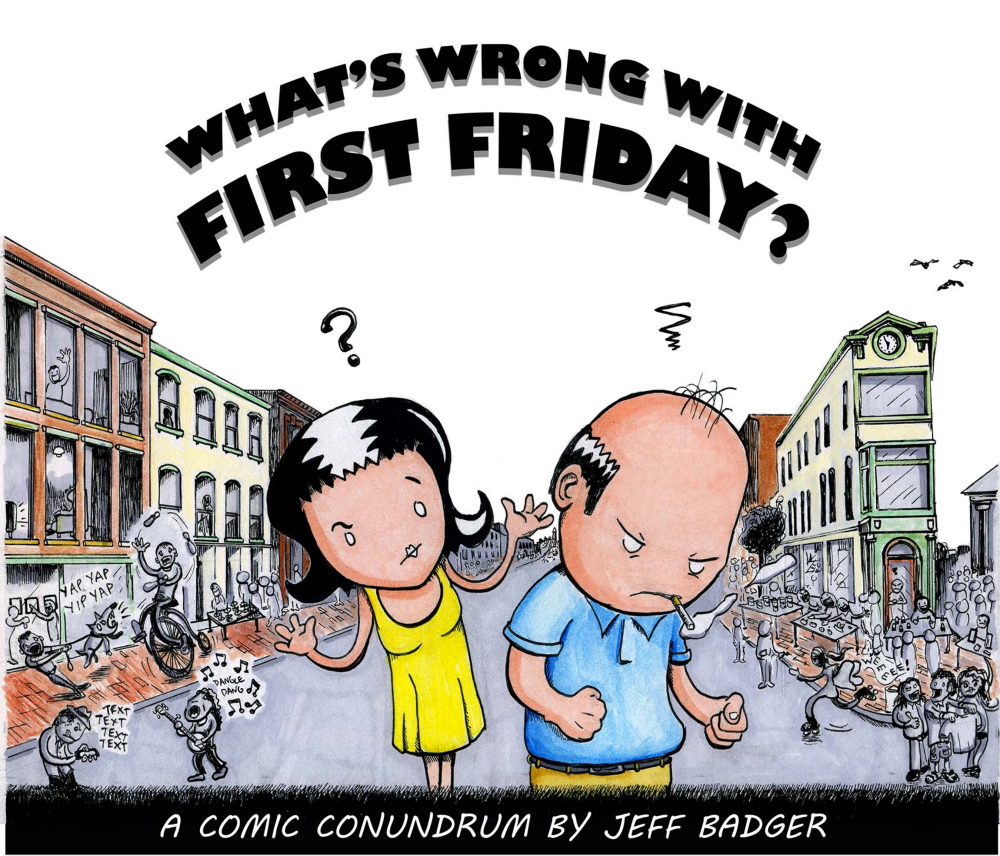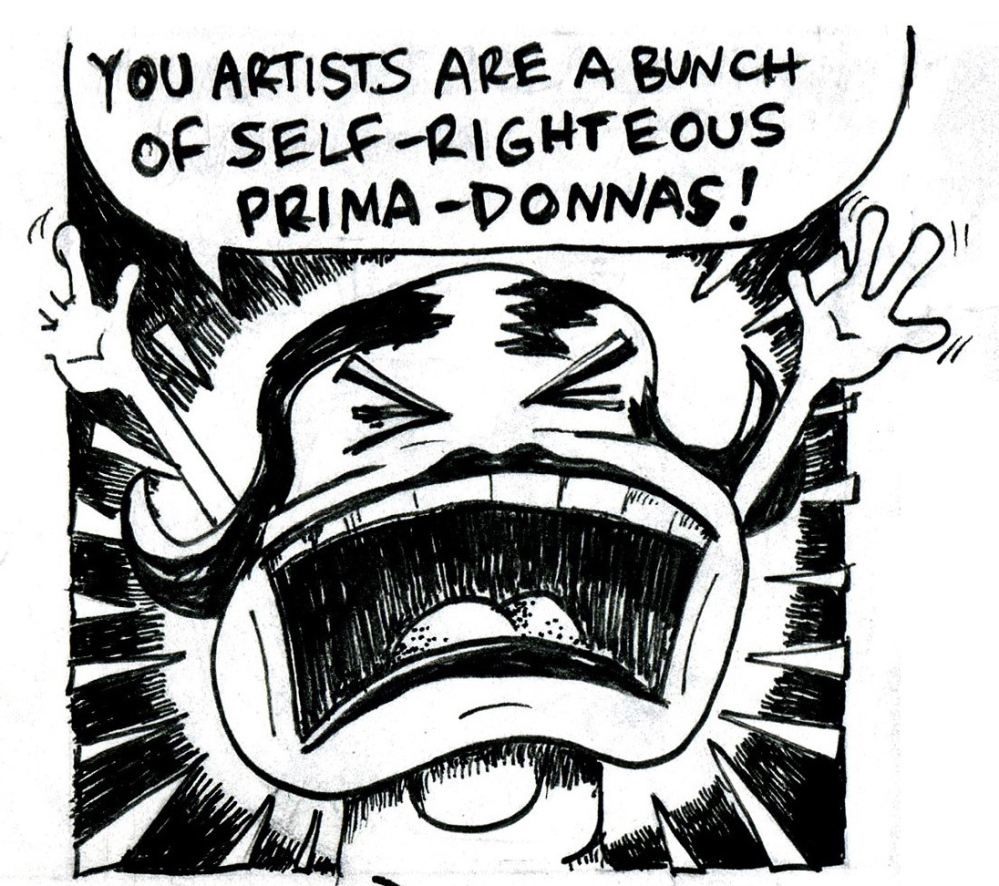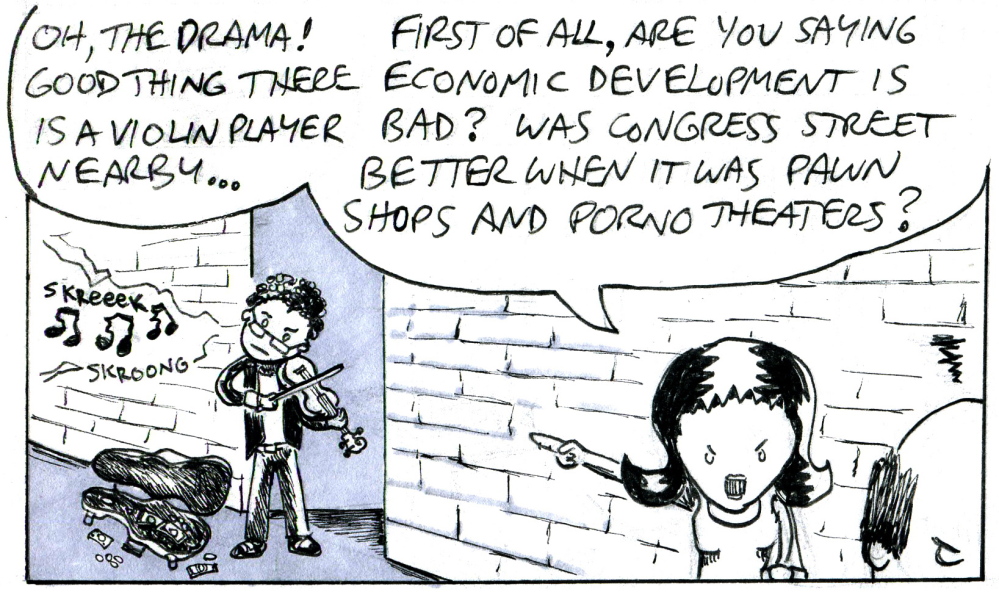Jeff Badger’s “What’s Wrong with First Friday” comic in the February issue of “The Bollard,” a monthly Portland magazine, is an impressive encapsulation of the leading opinions about Portland’s art walk.
With comics now taking a major role in American culture (“The Walking Dead” is wildly popular, for example, and the Marvel movie franchise has grossed more than any other at the box office), maybe I shouldn’t have been surprised. But I was. Art tends to simplify to imply, not to distill into clearly-articulated, opposing (and dialectally balanced) opinions, which is just what Badger has done.
While it is not like the art and exhibitions usually reviewed in this column, “What’s Wrong” is art. And because it’s insightful art about the most public art phenomenon in Maine, I think it’s worth examining with a critical eye.
“What’s Wrong” is a five-page comic of about 40 frames rendered in a charming but not childish style. Showcasing Badger’s mastery of many hip narrative tricks of current comics, “What’s Wrong” portrays a fictional debate about Portland’s First Friday Art Walk. Two friends, Max and Jen, meet downtown for a drink. When he realizes the town is crawling with people out for the art walk, Max, a middle-aged artist, flips from happy to surly and declares, “I hate First Friday!”
And so the debate begins.
Everyone interested in Maine arts should read this comic. While it’s just a few hundred words, the conversation between Max and Jen is vast. Badger not only provides the most succinct commentary about First Friday I have ever encountered, but he crafts the dialogue as a series of debatable points that invite readers to percolate their own opinions with each question mark.
Max positions himself by saying, “First Friday doesn’t really support the arts … at least not in a way that’s good for the artists. Maybe it used to, but it has really changed.” Jen doesn’t just offer an opposing point of view, she calls Max out again and again. Noting First Friday is now crowded and popular, Jen suggests that Max, instead of being irked by this, should be “happy to see all these people out supporting the arts.”
Sporting a “First Friday was cool when I was cool” attitude, Max sees all the performers and artists with their wares on the street as “panhandling” so there are “hardly any spaces left for serious artists to show work.” He argues “the artists and galleries that started (the art walk) were trying to create something serious and sustainable” but that “First Friday nowadays makes our scene seem kind of provincial and just a bit desperate.”
As Jen (who is far more comfortable with change and cultural dynamism) responds, the pair takes up restaurants and broader issues of economic development, even gentrification (“the magic word!”). Interestingly, they largely agree about the facts but disagree about what is good and what isn’t. The debate ends with the two agreeing their conversational “merry-go-round” has “lots of complaints, but no solutions.”
Assuming the deepest thrust of art in America is cultural commentary, Badger (who is also a prolific musician and the leading force behind the impressive art program at Southern Maine Community College) has directly struck the biggest and most public vein for art in Maine. He succeeds precisely because, instead of riding an essay’s linear singularity, Badger employs a painter’s sensibilities that can balance multiple elements. Moreover, he has done it in a non-gallery art format that adds ironic fuel to the debate about the (waning?) status of galleries.
Where there are artists, there are always complaints. Artists are, after all, creative and constructive engines for change. But First Friday is not controversial (and Badger subtly makes the point that various opinions don’t necessarily qualify as “controversy”).
By most accounts, First Friday is a massive success. To be clear, I agree with Jen. It’s flawed and could be improved, but First Friday is awesome.
Max claims First Friday seems “provincial and a bit desperate.” But the art walk isn’t a local phenomenon. It’s national. Coordinated art openings in Maine and elsewhere had been around for a long time before they began coming into focus under the title of “art walk.” I was a gallery director in Sun Valley, Idaho, and Seattle, where art walks had been around for a while before First Friday became a thing in Maine.
This is not to take credit away from the folks who helped create the local momentum and who would either defend its worth today or criticize what it has become, but it is a phenomenon of public culture, not a few privileged authors.
While First Friday is big and popular, the energy only partially comes from the artists, galleries, performers and institutions: Most of it comes from the enthusiastic public. A few galleries have closed recently (galleries always close), but there are more art venues now than in years past. PhoPa has blossomed. The Portland Public Library now has the Lewis Gallery. Roux & Cyr and The Portland Gallery are new. Susan Maasch just opened her expanded space. The Salt Institute for Documentary Studies, the Maine Jewish Museum and SPACE have all recently expanded their exhibition spaces. The Portland Museum of Art, a great museum that is free on Friday nights, is in the process of a campus expansion.
Pinned to First Friday, several of Portland’s leading professional galleries host openings the night before. For starters, it’s not amateur night at the bars – that alone keeps away collectors. More than anything else, I think it is the galleries we need to support in order to have a robust art scene. But restaurants, shops, bars and galleries all support each other. And their combined hospitality and marketing efforts are creating new generations of art fans and launching the monthly gallery schedule into public consciousness.
First Friday in Maine has achieved critical mass. It is a thriving cultural organism. And like most culture, it is a messy, unpredictable river of energy beyond the control of any individual. That is precisely why Badger was right not to encapsulate it as one simple thing.
Freelance writer Daniel Kany is an art historian who lives in Cumberland. He can be contacted at:
dankany@gmail.com
Send questions/comments to the editors.






Success. Please wait for the page to reload. If the page does not reload within 5 seconds, please refresh the page.
Enter your email and password to access comments.
Hi, to comment on stories you must . This profile is in addition to your subscription and website login.
Already have a commenting profile? .
Invalid username/password.
Please check your email to confirm and complete your registration.
Only subscribers are eligible to post comments. Please subscribe or login first for digital access. Here’s why.
Use the form below to reset your password. When you've submitted your account email, we will send an email with a reset code.